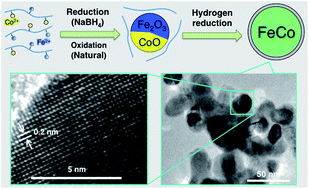Enhanced magnetization in highly crystalline and atomically mixed bcc Fe–Co nanoalloys prepared by hydrogen reduction of oxide composites†
Abstract
FexCo100−x nanoalloys (NAs) with 20 ≤ x ≤ 80 were prepared by hydrogen

* Corresponding authors
a Catalysis Research Center, Hokkaido University, Nishi 10, Kita 21, Sapporo 001-0021, Japan
b
International Institute for Carbon-Neutral Energy Research (WPI-I2CNER), Kyushu University, 744 Motooka, Nishi-ku, Fukuoka 819-0395, Japan
E-mail:
yamauchi@i2cner.kyushu-u.ac.jp
Fax: +81-92-802-6874
Tel: +81-92-802-6874
c JST-CREST, Gobancho 7, Chiyoda-ku, Tokyo 102-0076, Japan
d Research Laboratory of High-Voltage Electron Microscopy, Kyushu University, 744 Motooka, Nishi-ku, Fukuoka 819-0395, Japan
e Department of Applied Quantum Physics and Nuclear Engineering, Kyushu University, 744 Motooka, Nishi-ku, Fukuoka 819-0395, Japan
f Research Institute for Electronic Science, Hokkaido University, Sapporo 001-0020, Japan
g RIKEN SPring-8 Center, 1-1-1 Kouto, Sayo-gun, Hyogo 679-5148, Japan
h School of Science, The University of Tokyo, 7-3-1 Hongo, Bunkyo-ku, Tokyo 113-0033, Japan
FexCo100−x nanoalloys (NAs) with 20 ≤ x ≤ 80 were prepared by hydrogen

 Please wait while we load your content...
Something went wrong. Try again?
Please wait while we load your content...
Something went wrong. Try again?
M. J. Sharif, M. Yamauchi, S. Toh, S. Matsumura, S. Noro, K. Kato, M. Takata and T. Tsukuda, Nanoscale, 2013, 5, 1489 DOI: 10.1039/C2NR33467D
To request permission to reproduce material from this article, please go to the Copyright Clearance Center request page.
If you are an author contributing to an RSC publication, you do not need to request permission provided correct acknowledgement is given.
If you are the author of this article, you do not need to request permission to reproduce figures and diagrams provided correct acknowledgement is given. If you want to reproduce the whole article in a third-party publication (excluding your thesis/dissertation for which permission is not required) please go to the Copyright Clearance Center request page.
Read more about how to correctly acknowledge RSC content.
 Fetching data from CrossRef.
Fetching data from CrossRef.
This may take some time to load.
Loading related content
